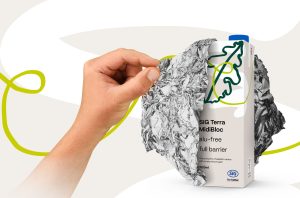Business a.m.
SIG, a leading aseptic carton packaging provider, has announced the commercial launch of SIG Terra Alu-free + Full barrier for multi-serve aseptic cartons. This development, considered an industry-first, buids on the successful introduction of the innovative packaging material for single-serve cartons, which has seen over 300 million packs sold in China since 2023. The company is now scaling up this groundbreaking technology to offer it globally for multi-serve formats.
The new packaging structure for multi-serve cartons, which completely eliminates the aluminium layer, is set to reduce the carbon footprint of SIG’s standard aseptic cartons by up to 61 per cent when combined with forest-based polymers. Made of over 80 per cent paper, the simplified material now consists of only two main raw materials, both of which can be linked to renewable sources.
Performance and scalability
Despite the removal of the aluminium, the new material offers the same full barrier protection as standard aseptic cartons, ensuring an identical shelf life of up to 12 months. The solution can run seamlessly on existing SIG carton filling lines with only minor, low-cost adaptations. This plug-and-play compatibility allows for high-speed production, reaching up to 24,000 packs per hour on small-size carton lines and up to 15,000 packs per hour on multi-serve lines. This ensures customers worldwide can leverage the environmental benefits without compromising product quality or production performance across a wide range of beverages.
Christoph Wegener, chief Markets Officer at SIG, commented: “At SIG, we are leading the industry transition to alu-layer-free aseptic carton packaging materials. With our full barrier material with no aluminum layer, we are offering a powerful differentiator and embodiment of sustainability in aseptic carton packaging, unlocking new opportunities for packaging sensitive product categories such as plant-based products, juices, and nutritional beverages. As a result, our SIG Terra portfolio now offers an aseptic carton solution without aluminum layer for all product categories we serve, without compromising on shelf life.”
Driving decarbonisation and innovation
The decarbonisation of the food and beverage industry is more critical than ever. Traditionally, an aluminium layer in aseptic cartons has been vital for protecting products from oxygen and light. While aluminium typically accounts for only around five per cent of a standard aseptic carton, it can contribute up to 25 per cent of its carbon footprint in a full-barrier package. Removing this layer is therefore a significant stride in further reducing the already low carbon footprint of SIG’s standard aseptic cartons. This innovation also simplifies the packaging structure from three to just two main raw materials, boosting the paper content to over 80 per cent.
SIG has been a pioneer in this field, first introducing an aluminium-layer-free packaging material for aseptic cartons in 2010 (SIG Terra Alu-free) for plain liquid dairy products. Building on this extensive experience, the company has continued to expand its aluminium-layer-free aseptic carton portfolio.
The SIG Terra Alu-free + Full barrier solution addresses oxygen-sensitive products like fruit juices, nectars, flavoured milk, or plant-based beverages. SIG plans to roll out this full barrier solution across all its flagship aseptic carton formats, both small-size and multi-serve, suitable for all beverage and dairy categories incrementally.
Since 2010, SIG has sold over four billion packs featuring no aluminium layer, including 300 million alu-free full-barrier cartons, reinforcing its leadership in sustainable aseptic packaging.
Gavin Steiner, chief technology officer at SIG, dwelled on the company’s future ambitions, stating: “Sustainability is integral to our business, and we strive to create a regenerative food packaging system. Looking ahead, SIG plans to raise the paper content in its aseptic cartons to at least 90% including closures by 2030, with an interim target of 85% without closure this year – further boosting renewability, lowering carbon footprints, and with the potential to streamline the recycling process for aseptic cartons, only requiring the separation of paperboard and polymers.”









